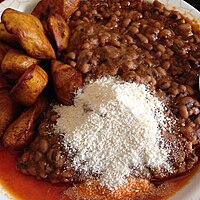82.131.184.157 (talk) |
Pekinensis (talk | contribs) mv hu:Bab to common bean |
||
| Line 84: | Line 84: | ||
[[de:Bohne]] |
[[de:Bohne]] |
||
[[fr:Haricot]] |
[[fr:Haricot]] |
||
[[hu:Bab]] |
|||
[[nl:Boon]] |
[[nl:Boon]] |
||
[[ja:豆]] |
[[ja:豆]] |
||
Revision as of 17:58, 20 August 2005
- This article is on the plant. For alternate meanings, see Bean (disambiguation)
Bean is a common name for large plant seeds of several genera of Fabaceae (formerly Leguminosae) used for food or feed.
Name
Bean originally meant the seed of the broad bean, but was later broadened to include members of the genus Phaseolus such as the common bean or haricot and the runner bean and the related genus Vigna. The term is now applied in a general way to many other related plants such as soybeans, peas, lentils, vetches and lupins.

Bean can be used as a near synonym of pulse, i.e. an edible legume, though the term "pulses" is usually reserved for those leguminous crops which are harvested for their dry grain. Pulses then exclude those crops mainly used for oil extraction (like soybean and peanut) or those used exclusively for sowing purposes (clover and alfalfa). Leguminous crops harvested green for food like snap beans, green peas etc. are classified as vegetable crops.
In English usage beans sometimes also refer to seeds or other organs of non leguminosae, for example coffee beans, castor beans and cocoa beans (which resemble bean seeds), and vanilla beans (which resemble the pods).
In 1889, Justice Joseph Philo Bradley of the United States Supreme Court ruled, in Robertson v. Salomon (130 U. S. 412), that a bean is a vegetable and not a seed. In his decision, Bradley stated that:
- "We do not see why they should be classified as seeds, any more than walnuts should be so classified. Both are seeds, in the language of botany or natural history, but not in commerce nor in common parlance. On the other hand in speaking generally of provisions, beans may well be included under the term 'vegetables.' As an article of food on our tables, whether baked or boiled, or forming the basis of soup, they are used as a vegetable, as well when ripe as when green. This is the principal use to which they are put. Beyond the common knowledge which we have on this subject, very little evidence is necessary, or can be produced."
Types of bean
- Vicia
- V. faba or broad bean
- Vigna
- V. angularis or azuki bean
- V. radiata or mung bean
- V. umbellatta or rice bean
- V. unguiculata or cowpea (includes the black-eyed pea, yardlong bean and others)
- several others
- Cicer
- C. arietinum or chickpea
- Pisum
- P. sativum or pea
- Lens
- L. culinaris or lentil
- Lablab
- L. purpureus or hyacinth bean
- Phaseolus
- P. acutifolius or tepary bean
- P. coccineus or runner bean
- P. lunatus or lima bean
- P. vulgaris or common bean (includes the pinto bean, kidney bean and many others)
- Glycine
- G. max or soybean
- Psophocarpus
- P. tetragonolobus or winged bean
- Cajanus
- C. cajan or pigeon pea
- Stizolobium
- S. spp or velvet bean
- Cyamopsis
- C. tetragonoloba or guar
- Canavalia
- C. ensiformis or jack bean
- Macrotyloma
- M. uniflorum or horse gram
- Lupinus
- L. mutabilis or tarwi
Cultural aspects
The following traditional uses of beans refer to the broad bean.
In ancient Greece and Rome, beans were used in voting (a white bean meant yes and a black bean meant no) and as a food for the dead, such as during the annual Lemuria festival.
In some folk legends, such as in Estonia and the common Jack and the Beanstalk story, magical beans grow tall enough to bring the hero to the clouds. The Grimm Brothers collected a story in which a bean splits its sides laughing at the failure of others.
Dreaming of a bean is sometimes said to be a sign of impending conflict, though others said they caused bad dreams.
Pliny claimed they acted as a laxative.
European folklore also claims that planting beans on Good Friday or during the night-time is good luck.
Trivia
- In 2005, a poll of 2,000 people revealed the bean to be Britain's 9th favourite culinary vegetable.